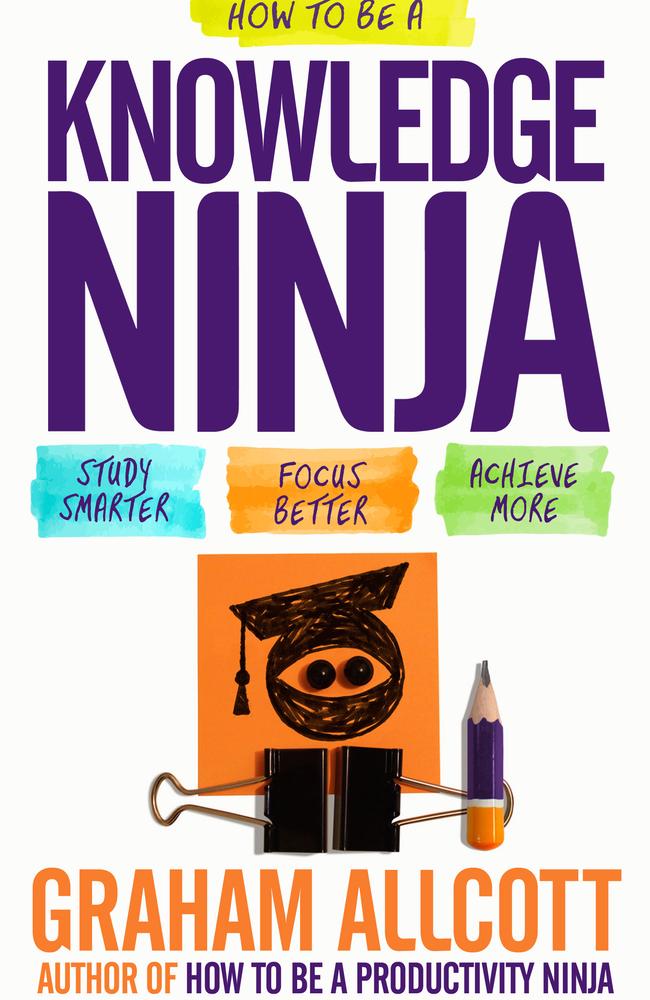Eleven strategies for getting started
DO YOU feel paralysed by procrastination? Constantly distracted? Surrounded by too many post-it notes and to-do lists? Try these tips. They work.
DO YOU feel paralysed by procrastination? Surrounded by too many scrappy notes with unfinished to-do lists?
In today’s world of smartphones, Twitter and always-on internet, it’s becoming harder and harder to sit down and actually concentrate.
So how do you cut through the distractions and get back to productive working?
According to productivity expert and author Graham Allcott, founder of consultancy Think Productive, it’s simple: think like a ninja.
Allcott’s new book, How to be a Knowledge Ninja, outlines some practical tips to cutting through the daily clutter.

Here are 11 strategies you can use to get started:
1. MICROGOALS

Writing an essay or working on something big can seem frustrating. This is because the brain releases a chemical called dopamine into the brain when we complete things. In fact, dopamine is often known as the reward molecule. Its function in evolutionary terms was to make sure that we found happiness and value in hunting food before we were hungry in case, when we did get hungry, no food was available to kill. And the reason we’ve evolved and survived as a species? Dopamine is highly addictive. A microgoal with a 2,000 word essay might be to do 250 words a day. Guess what? If that’s your microgoal and you hit it, you’ll feel good about having done 250 words and won’t be feeling bad that you haven’t yet done the other 1,750. And if you hit your microgoal every day for a week and a day, you’ve finished your essay without even realising it. Anything you’re working on can be broken down into microgoals.
2. GO DARK

A recent study found that for every one-minute email interruption, it takes on average fifteen minutes to recover and get back onto the thing you were doing. So all those little tiny distractions add up to a huge inefficiency. Sometimes what you’re doing needs total focus. For these times, go dark. ‘Going dark’ is a phrase that is thought to have originated among software developers in the days before a big deadline. When they’re working away on something that requires total focus, they disappear off the radar. They’re not answering their phones or emails and you don’t know where they are in the office (assuming they’re even in the office at all). I use this tactic regularly, because I think there are certain tasks where I’m very prone to procrastination if I don’t have total focus, but actually once I do focus, it becomes really clear what I need to do and how to get started.
3. DON’T AVOID THE BLANK PAGE

One of the hardest things about getting started is staring at a blank page. So much so that it almost repels you from sitting down to start. We avoid even the thought of staring at the blank page because it feels daunting, and the infinite possibility of it feels somehow threatening. ‘How can I possibly turn this into something valuable?’, we think. Well, you know what? Every book you’ve read started with a blank page. Star Wars was once a blank page. Your favourite album of all time was once a blank page. Everything invented was once a blank page. But you know how each and every one of those things got good? They got good because the first draft was shitty. The ideas evolved, they didn’t just arrive in perfect form. So just write something. Start something. Anything! It doesn’t matter for now what it is, how good it is, whether you end up ditching it or using it. It’s just that sometimes, having something to disagree with is the first step to knowing what you want to do. And seeing some words on the page gives you something to do, rather than staring into the infinite abyss of a page of white nothingness.
4. ONE POMODORO

The Pomodoro Technique involves breaking down work into 25-minute intervals separated by short breaks. So grab a kitchen timer, or a Pomodoro app on your phone, and just do the first 25 minutes of the thing that’s scaring you. You don’t need to finish it, it’s not important how far you get, but just start it. I often use this technique with things that I find mind-numbingly boring, like filling in excel spreadsheets about finances. What I find is that one Pomodoro is always enough to turn my discomfort with a task into something more comfortable. And the thought of just spending 25 minutes on something rather than feeling trapped and hemmed in by the idea of spending the whole morning on it makes it easier for me to get going. At the end of one Pomodoro, I’m usually happy to carry on until the thing is finished, so it’s a great way of tricking myself into getting going. You don’t even need to do 25 minutes, either. You could use this same tip but just change it to doing ‘the first five’. Often, five minutes and the act of starting will be enough to create some momentum and help you get over your fear.
5. OVERPROMISE (SOMETIMES)

Generally, overpromising on things is a terrible and destructive habit. But there’s a time when overpromising can actually be one of the greatest productivity weapons you have — and that time is when you’re procrastinating and need the accountability of having something to prove. Saying yes, against your better judgment, throwing down a challenge to yourself to get something done on a ridiculously tight timescale can be thrilling and exciting. The power of the deadline or expectation it creates can get you over the start line and hurtling towards completion with momentum that goes off the usual scale. It forces you to commit, forces you to follow through and in turn, forces you to say no to lots of other things that will come your way, as you manage the monster you have created. This isn’t for the faint of heart and shouldn’t be a trick you practise regularly, but a little bit of exhilaration and the occasional late night are fine; I’d argue that they’re part of life’s rich tapestry of experiences and are to be celebrated. Just be careful not to make this a regular part of your routine.
6. TURN ‘I DON’T KNOW’ INTO ‘WHAT IF I DID KNOW?’

The language we use with ourselves determines what we think about things. We convince ourselves that we don’t know where to start. We convince ourselves that we don’t know what to do. We convince ourselves that we don’t know anything at all. And yet this is never true. We always know where to start, even if the place we should start is to ask someone else’s advice, or flesh out what it is we’re stuck on. Being stuck and not knowing are two very different things. We confuse them regularly, but deep down, we always know. So next time you get into an inner-narrative that goes something like this … ‘Where should I start? Ohhh, I don’t know …’ … continue this conversation by adding a new question: ‘But what if I did know? What would the answer be then?’ What if you really did know what to do? What would that ‘doing’ look like? Make it hypothetical for a moment if that helps you. Imagine what someone else would be doing if they knew the answer. Then start with that.
7. PRODUCTIVE PROCRASTINATION

Here’s a Ninja secret. Sometimes it’s okay to procrastinate … because other things get done! Procrastinating by tidying your room, or cooking a massive chilli con carne to feed you for a week, or even by going to bed early to get enough sleep so that you’ll feel fresher tomorrow aren’t the worst things you can do. Much worse than any of these things is procrastinating with activities that contribute nothing to your sense of achievement or balance. When I’m writing a book, it’s amazing how clear my email inbox is. My logic is that if I’m avoiding writing, the least I should do is avoid it by hiding somewhere worthwhile, so I answer all my emails. It’s amazing how much being scared of a bigger thing motivates you to do other things that were themselves previously too scary, or just boring or difficult. What if I told you your procrastination can be a productivity weapon to everything else in the world, as well as a barrier to the one thing you’re procrastinating about? Recognise that we all have off days. It’s part of life. Choose Productive Procrastination over the more pernicious type.
8. DOPAMINE RUSHES

Linked to this is the idea of chasing dopamine rushes. The brain feeds you dopamine whether you’re tidying your desk or tackling an assignment, so when we’re Productively Procrastinating, we’re often just chasing the next little ‘hit’ of dopamine. And it is highly addictive — it’s also the chemical linked to alcohol abuse, gambling and a whole slew of other addictive behaviours. So set up a little string of dopamine rushes to strive for. The first could be completing tidying your desk, the second could be filling out that annoying bank form you’ve been putting off, and then the third one could be drafting the outline for the essay. Before, it was the essay you were avoiding, but now it’s just the third hit of dopamine. And once you’ve chased down those other two, your brain will be hungry for more. Your brain will be tricked into seeing the scary task as being the same as those other more trivial ones once you’re on a roll.
9. GO WEIRD

Procrastination and the stress it brings can be crippling. It can produce such inactivity and stasis that it makes you feel ‘stuck in a rut’, unable to do anything to break free. Sometimes, when your usual techniques aren’t shifting the blockage, you need to go weird. Try picking a word at random. And if that sounds like too much pressure (or if you want to make sure it’s truly random) you can find a random word by opening a dictionary at a random page, clicking Google’s ‘I’m feeling lucky’ button (without searching for anything) or picking a website like the BBC and choosing the 28th word on the first page you see. Now, see what you can do to incorporate that word into how you’re working, or even what you’re working on. So let’s say the word that pops up is ‘Chinese’, then maybe take your laptop to a Chinese restaurant or go sit on a bench in Chinatown, or make a China plate your desk for the day. This isn’t as ridiculous as it sounds. A sense of playfulness can help reduce stress, and breaking with even the tiniest of conventions can help overcome the bigger barriers that you’re trying to overcome.
10. CREATE A DEADLINE IN SOMEONE ELSE’S WORLD

The carrot or the stick? It’s far better to learn to create your own carrots (like microgoals, for example) and be self-motivated, than to need to constantly rely on the prospect of stick punishments to motivate you into action. But there are times when the stick has its place. Websites like stickk.com can create the ultimate in harsh motivation. Lots of websites or books that talk about beating procrastination will mention setting your own internal deadlines. I think this is a load of nonsense. A deadline is only a deadline if you’ll be dead if you don’t get over the line. And if the person monitoring you to meet the deadline is you, then you’ll secretly know that if you don’t meet the deadline, nothing will happen. Far better to create a deadline in someone else’s world. Having someone else depending on you delivering something at the right time — whether that’s your tutor, a family member, or someone else on your course — is the only way to make a deadline an effective tool.
11. ANTI-PERFECTION

Perfection is a disease. A Knowledge Ninja knows that too much emphasis on achieving perfection can leave us crippled by the prospect of failing to achieve it. But why do we obsess over perfection, anyway? There are of course times when perfect matters — if you’re checking the plane’s safety features or performing triple heart bypasses, then it’s probably a good idea to aim for perfect. But most of the time, the aim should be ‘good enough’. Once something is good enough, it’s time to move on to the next thing. I like to think that there’s a certain glory in imperfection. A perfect world full of perfect things becomes boring — if every day in your life the weather is the same, then the weather doesn’t really exist as a feature of your life. It’s the 2% imperfection that gives the other 98% its character and value. And ultimately when we fail at things or things don’t go perfectly, it’s a reminder that we’re human beings after all, and is a reminder of how remarkable that other 98% of our achievement really is. So seek out the Knowledge Ninja’s secret source of power — ‘just enough’ — right from the start. Never let yourself get obsessed with perfection and celebrate the rough edges.
This is an edited extract from How To Be A Knowledge Ninja: Study Smarter. Focus Better. Achieve More by Graham Allcott. $27.99. Icon Books from Allen & Unwin, published on 26 March 2015.



